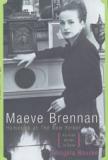Odyssey of the Long-Winded Lady'
In 1997, literary luminaries like Alice Munro and Mavis Gallant hailed a collection of stories written by an Irish writer named Maeve Brennan. Entitled The Springs of Affection: Stories of Dublin (Houghton Mifflin), these stories were set in Ireland and often revolved around young girls or women. The stories seemed to be autobiographical, even if you knew nothing about the author’s lifewhich, as it turned out, was quite extraordinary. But Brennan’s later life was not the stuff of her fiction. The stories from Springs of Affection were typically quiet, domestic tales, often with a climax that seemed uneventful, yet disturbing nonetheless.
Springsfollowed by several other new works of fiction by Brennanmade for a heartening literary story. Many readers lament that great writers go unread. Here was an undeniably beautiful writer seemingly rediscovered.
The trouble is that Brennan’s career, before she died in November 1993, was a storied and accomplished one. She was no struggling scribe working anonymous day jobs and dreaming of literary fame by night. There was a time, in fact, when Brennan was known by some around the hallowed halls of The New Yorker as the greatest living story writer. No less a luminary than William Maxwell penned the introduction to the new edition of Springs of Affection. This is not to take away from any of Brennan’s accomplishments. Perhaps it merely illustrates the fleeting nature of literary fame.
Either way, Brennan’s popularity only seems to be growing. Now she is the subject of a biography by Angela Bourke. Inevitably, a number of troubling questions are raised by the title of Bourke’s book. To begin with, the last thing the world needs is yet another look at a member of the New Yorker fraternity.
Then there is the length of that title. How many angles can a publisher cram into a title before putting a fear in the reader’s mind that the author is simply reaching too far and wide?
Some may even ask: Who is Maeve Brennan? And if you have to ask that, you may wonder why you should read a biography of her. But Bourke’s book is a good one. She sets out to write not merely a straight biography of one writer but a cultural history of this writer’s life and times. Again, this can be a warning signal, suggesting the biographer’s subject alone is simply not compelling enough.
But Bourke has selected her topic well. Brennan’s parents were deeply involved in key political and cultural struggles of their time (the end of the 19th century and beginning of the 20th century in Ireland). The Brennans and their circle wrote plays, ran for office and, when it was needed later on, aided in the armed struggle for Irish independence.
Born in 1917, Maeve Brennan herself absorbed her parents’ cultural rather than political influences. Early on she was a promising writer and performer. America beckoned the strikingly beautiful Brennan, who relocated to New York City. She landed work at fashion magazines and began mingling with a high- class crowd.
Bourke, the author of The Burning of Bridget Cleary and a lecturer at University College, Dublin, does a fine job recreating Brennan’s time in Manhattan and her ambiguous relationship with Ireland. She clearly loved her native country and had strong family ties. Yet in the end she chose to remain in the United States, ultimately prompting Maxwell to write, I don’t know whether in Ireland she is considered an Irish writer or an American. (He added: In the end, both countries have claimed her.)
According to Bourke, Brennan dazzled everyone who met her on her way to earning a reputation as one of the finest short story writers around. She was also publishing regularly in The New Yorker, eventually penning the Long-Winded Lady in the Talk of the Town department.
In the end, Bourke’s book would be a success if it simply told a story of culturally committed parents during a time of transition in Ireland and their talented daughter in New York. But Bourke has one final, shocking angle on Brennan’s story. Eventually, Brennan would suffer from mental problems that left her more or less homeless. She spent some nights at The New Yorker offices, others in sleazy hotels. Her erratic behavior alienated once-close friends like Maxwell. Still, when she died in 1993, there were enough friends who remembered her fondly to give her a proper send-off. Her ashes were then sent back to family in Ireland.
Bourke reaches too far when she calls Maeve Brennan an icon of the 20th century. But like Bourke’s book, the story of the Brennan family does indeed shed revealing light on broader aspects of Irish history, New York literary culture and one fascinating, troubled, profoundly talented artist.
This article also appeared in print, under the headline “Odyssey of the Long-Winded Lady',” in the December 6, 2004, issue.








